1966-2000 - 200 Years - Coins and medals - Timeline and pictures
By Museum Victoria | Thursday, 22 November 2007
In 1988, Australia celebrated 200 years since the arrival of the First Fleet. The festivities were accompanied by protest about the impact of European settlement on the indigenous population.
Australian school children were issued with a Bicentennial commemorative medal, designed by Michael Meszaros, whose father Andor produced the Olympic participants' medal.
Silver 50 cent coin, 1966
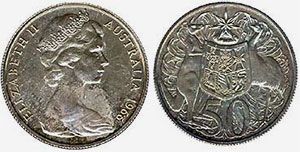
When decimal coinage was introduced to Australia in February, 1966 a new portrait of the Queen accompanied it. The portrait, seen here on the 1966 silver 50 cents coin, was by the London artist Arnold Machin. This coin was a special piece struck in London and sent to Australia as a sample of the new coinage. Round silver 50 cents pieces were only struck bearing the date 1966.
Obverse - Bust of Elizabeth II facing right, and around it legend ELIZABETH II AUSTRALIA 1966.
Reverse - Arms of Australia with the denomination '50' below.
50th Anniversary of Gallipoli medal, 1965
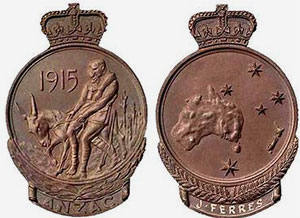
This medal was awarded to commemorate the 50th anniversary of the ANZAC Gallipoli landings. Issued in 1967, medals were available only to survivors of Gallipoli and their next of kin. This example was issued to J. Ferres. In addition to the medal, a small replica to be worn as a lapel badge was also issued.
Obverse - Private John Simpson of the Army Ambulance Corps aiding a wounded soldier on his donkey at Gallipoli, with the date 1915. Below on a plaque is the word ANZAC.
Reverse - A map of Australia and New Zealand set among the stars of the Southern Cross. Below on a plaque is engraved the recipient's name, J. FERRES.
Vietnam Service medals, 1964 - 1974
These are the campaign medals awarded to Australians who served in South Vietnam between 1964 and 1974. The Australian Vietnam Medal was designed by Andor Meszaros. Those who served for more than six months were also awarded the medal supported by a green and white ribbon - the South Vietnam Campaign Medal presented by the South Vietnamese government. The medals shown here have not been awarded.
Obverse - South Vietnam Campaign medal - Formed of a bronze gilt six pointed star enamelled white with gilt rays in their angles. The central feature is an outline map of Vietnam.
Reverse - Australian Vietnam medal - Below the legend VIET NAM is a nude male figure holding apart two symbolic ideological spheres.
Medal for flight of Apollo 8, 1968
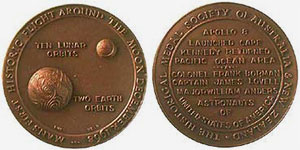
This is a medal issued in Australia to commemorate the first manned lunar orbit flight in December 1968. The crew, Frank Borman (commander), James A. Lovell and William A. Anders photographed the lunar surface, both farside and nearside and obtained information needed for future Apollo landings.
Obverse - Images of the Earth and the Moon with the legend TEN LUNAR ORBITS TWO EARTH ORBITS. Around this is the legend MANS FIRST HISTORIC FLIGHT AROUND THE MOON DECEMBER 1968.
Reverse - The legend: THE HISTORIC MEDAL SOCIETY OF AUSTRALIA & NEW ZEALAND. APOLLO 8 LAUNCHED CAPE KENNEDY RETURNED PACIFIC OCEAN AREA COLONEL FRANK BORMAN CAPTAIN JAMES LOVELL MAJOR WILLIAM ANDERS ASTRONAUTS OF UNITED STATES OF AMERICA.
Medal for James Cook bicentenary, 1970
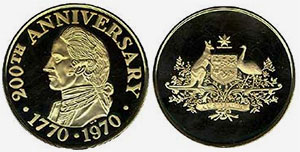
This is one of more than 40 different commemorative medal issues inspired by the 1970 bicentenary of Captain James Cook's arrival in Australia. The popularity of the event is indicated by the fact that over 4000 of these large gold medals were made.
Obverse - Bust of James Cook facing left with the legend around 200TH ANNIVERSARY 1770 - 1970.
Reverse - Australian Arms.
Medal for the Gothic Bank, 1976
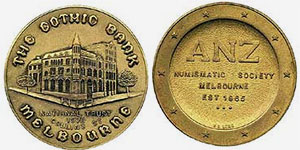
Decimalisation in the mid-1960s saw a number of new collector societies formed. One was the ANZ Bank Numismatic Society, which was formed in1965. Ten years later, the society commemorated the ANZ Bank's Gothic Bank in Bourke Street Melbourne by the issue of this medal.
Obverse - A corner view of the Gothic Bank on the corner of Queen and Collins Streets with the legend THE GOTHIC BANK NATIONAL TRUST 1975 COLLINS STREET MELBOURNE.
Reverse - Within a border of stars it has the legend ANZ NUMISMATIC SOCIETY MELBOURNE EST. 1965. In small letters below this is the makers name K.G.LUKE.
Medal for 75th anniversary of Australian Federation, 1976
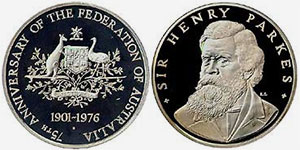
This is one of a set of seven silver commemorative medals made in Birmingham, England for sale to Australian collectors on the occasion of the 75th anniversary of Federation. This example features Sir Henry Parkes, considered by many the 'Father of Federation'.
Obverse - Bust of Sir Henry Parkes surrounded by the legend SIR HENRY PARKES.
Reverse - At the centre is the Arms of Australia above the dates 1901 - 1976. Around these is the legend 75TH ANNIVERSARY OF THE FEDERATION OF AUSTRALIA. A tiny 'H' below the date is the makers mark, Heaton & Sons, Birmingham, England.
Medal for Bicentenary of the death of Captain Cook, 1979
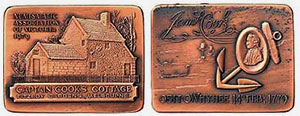
This medal was issued in 1979 by the Numismatic Association of Victoria to commemorates the bicentenary of the death of Captain James Cook. The designers, Terry Pepperell and Betty Turvey, were members of the Association. The cottage represented on the reverse was brought to Melbourne as part of the Melbourne Centenary celebrations in 1935.
Obverse - A bust of Cook in an oval set on an anchor, before which are canoes and sailing ships. Above this is a facsimile of James Cook's signature. Below it is the Latin legend OBIT:OWHYHEE 14th FEBy, 1779. [He died at Hawaii 14th February 1779].
Reverse - A view of 'Captain Cook's Cottage', and above it the legend NUMISMATIC ASSOCIATION OF VICTORIA 1979. Below on a plaque is the legend CAPTAIN COOK'S COTTAGE FITZROY GARDENS, MELBOURNE.
Halley's Comet medal, 1986
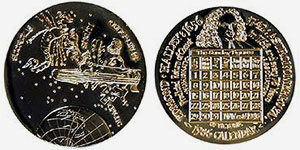
This is one of many medals produced in Australia to celebrate the return of Halley's Comet in 1986. The comet is named after Halley because he foretold its return in 1758 and every 75 years thereafter. The period of its orbit is by coincidence close to that of a human lifetime - perhaps explaining why this, among all comets, is the most famous.
Obverse - A pictorial representation of Halley's Comet in the sky above Australia.
Reverse - A bust of Halley facing out, above a calendar. Around is the legend EDMOND HALLEY 1656 1742: ASTRONOMER ROYAL Predicted Return of Comet In 1758 and every 75 Years. NUMISMATIC ASSOCIATION VICTORIA 1986 CALENDAR.
Medal for Victorian of the Year, 1988
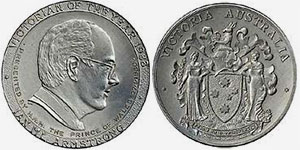
Ian Armstrong was selected as the Victorian of the Year for the Bicentenary year 1988. He personally commemorated the honour by having a medal struck. This one was presented to the Museum collection.
Obverse - Bust of Ian Armstrong facing right, and around this is the legend VICTORIAN OF THE YEAR IAN M.L. ARMSTRONG PRESENTED BY H.R.H. THE PRINCE OF WALES 27.1.1988.
Reverse - At the centre is the arms of the State of Victoria with the legend above VICTORIA AUSTRALIA.
Medal for Victorian Arts Centre, 1989
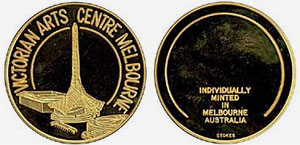
This medal was produced as a tourist memento of the Victorian Arts Centre and features the Centre's original spire. The replacement of the spire and changes to the National Gallery of Victoria's building, have made this an historic record.
Obverse - Features the spire of the Arts Centre and surrounding buildings, and around them the legend VICTORIAN ARTS CENTRE.
Reverse - The legend INDIVIDUALLY MINTED IN MELBOURNE AUSTRALIA and the makers name STOKES.
Medal for James Galloway grave restoration, 1992
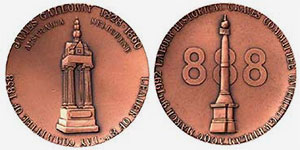
This medal was produced to help raise funds for the preservation and restoration of the historical graves of notable people associated with the Labour Party. It was sold at the time of the unveiling by Gough Whitlam of the restored grave of the Eight-hour day movement leader James Galloway.
Obverse - At the centre is Galloway's restored grave monument. Around it is the legend JAMES GALLOWAY 1828 - 1860 LEADER OF 8HRS DAY COMMITTEE OF 1858 AUSTRALIA MELBOURNE.
Reverse - At the centre is the Eight-hour monument, unveiled in 1903. Behind the monument is the 888 symbol as it appears on the monument, representing 8 hours labour, 8 hours recreation and 8 hours rest. Around it is the legend LABOR HISTORICAL GRAVES COMMITTEE UNVEILLED G WHITLAM ACQC MARCH 9TH 1992.
The Taltarni Wine Award, 1993
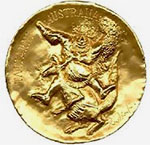
The Taltarni Vineyards instigated an award for services to Australian wine industry and commissioned the artist Ronald Searle to design the prize medal. This example of the medal was presented to the Museum both of a medal related to the wine industry and as an example of late twentieth century medallic art.
Obverse - A cartoon-like representation of Bacchus, the god of wind, riding a Kangaroo with the legend TALTARNI AUSTRALIA and the signature of the artist Ronald Searle.
Melbournese Jewellers press medal, 1996
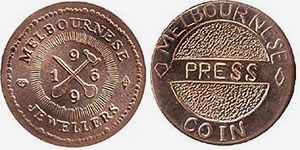
This small medal was struck by one of the members of the Melbournese Jewellers Association in 1996 to accompany a press release promoting a Jewellers medal series. Every year since, the Melbournese Jewellers have designed and struck a series of medals to encourage members to develop this ancient skill.
Obverse - The Melbournese Jewellers logo with the legend MELBOURNESE JEWELLERS 1996.
Reverse - The legend MELBOURNESE PRESS COIN.
Australian silver dollar, 1999
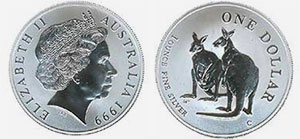
A one ounce 99.9% pure silver dollar, this is one of a series struck each year for collectors by the Royal Australian Mint. A different kangaroo is featured each year. This coin features the last Royal portrait of the century - the new portrait by the British artist Ian Rank-Broadley.
Obverse - Crowned bust of Queen Elizabeth II facing right and around it the legend ELIZABETH II AUSTRALIA 1999.
Reverse - Two kangaroos with the legend around ONE DOLLAR 1 OUNCE FINE SILVER.



